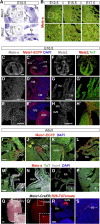Meis transcription factors regulate cardiac conduction system development and adult function
- PMID: 39691060
- PMCID: PMC12012448
- DOI: 10.1093/cvr/cvae258
Meis transcription factors regulate cardiac conduction system development and adult function
Abstract
Aims: The cardiac conduction system (CCS) is progressively specified during development by interactions among a discrete number of transcription factors (TFs) that ensure its proper patterning and the emergence of its functional properties. Meis genes encode homeodomain TFs with multiple roles in mammalian development. In humans, Meis genes associate with congenital cardiac malformations and alterations of cardiac electrical activity; however, the basis for these alterations has not been established. Here, we studied the role of Meis TFs in cardiomyocyte development and function during mouse development and adult life.
Methods and results: We studied Meis1 and Meis2 conditional deletion mouse models that allowed cardiomyocyte-specific elimination of Meis function during development and inducible elimination of Meis function in cardiomyocytes of the adult CCS. We studied cardiac anatomy, contractility, and conduction. We report that Meis factors are global regulators of cardiac conduction, with a predominant role in the CCS. While constitutive Meis deletion in cardiomyocytes led to congenital malformations of the arterial pole and atria, as well as defects in ventricular conduction, Meis elimination in cardiomyocytes of the adult CCS produced sinus node dysfunction and delayed atrio-ventricular conduction. Molecular analyses unravelled Meis-controlled molecular pathways associated with these defects. Finally, we studied in transgenic mice the activity of a Meis1 human enhancer related to an single-nucleotide polymorphism (SNP) associated by Genome-wide association studies (GWAS) to PR (P and R waves of the electrocardiogram) elongation and found that the transgene drives expression in components of the atrio-ventricular conduction system.
Conclusion: Our study identifies Meis TFs as essential regulators of the establishment of cardiac conduction function during development and its maintenance during adult life. In addition, we generated animal models and identified molecular alterations that will ease the study of Meis-associated conduction defects and congenital malformations in humans.
Keywords: Cardiac development; Mouse targeted mutation; PR elongation; Sinus node dysfunction; Transcription factor.
© The Author(s) 2024. Published by Oxford University Press on behalf of the European Society of Cardiology.
Conflict of interest statement
Conflict of interest: none declared.
Figures






References
-
- Moscow JA, Huang H, Carter C, Hines K, Zujewski J, Cusack G, Chow C, Venzon D, Sorrentino B, Chiang Y, Goldspiel B, Leitman S, Read EJ, Abati A, Gottesman MM, Pastan I, Sellers S, Dunbar C, Cowan KH. Engraftment of MDR1 and NeoR gene-transduced hematopoietic cells after breast cancer chemotherapy. Blood 1999;94:52–61. - PubMed
-
- Oulad-Abdelghani M, Chazaud C, Bouillet P, Sapin V, Chambon P, Dollé P. Meis2, a novel mouse Pbx-related homeobox gene induced by retinoic acid during differentiation of P19 embryonal carcinoma cells. Dev Dyn 1997;210:173–183. - PubMed
-
- Nakamura T, Jenkins NA, Copeland NG. Identification of a new family of Pbx-related homeobox genes. Oncogene 1996;13:2235–2242. - PubMed
MeSH terms
Substances
Grants and funding
LinkOut - more resources
Full Text Sources
Molecular Biology Databases
Research Materials

